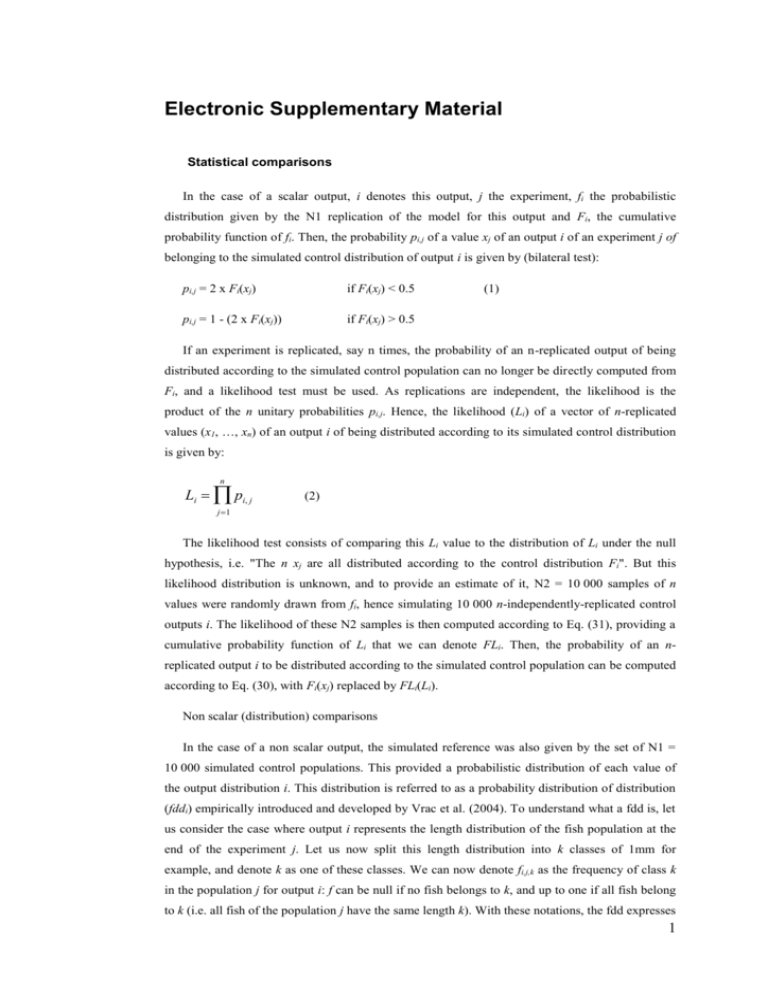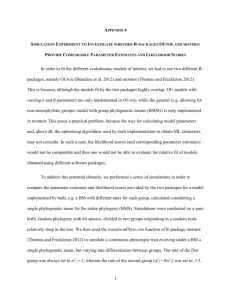Author template for journal articles
advertisement

Electronic Supplementary Material Statistical comparisons In the case of a scalar output, i denotes this output, j the experiment, fi the probabilistic distribution given by the N1 replication of the model for this output and Fi, the cumulative probability function of fi. Then, the probability pi,j of a value xj of an output i of an experiment j of belonging to the simulated control distribution of output i is given by (bilateral test): pi,j = 2 х Fi(xj) if Fi(xj) < 0.5 pi,j = 1 - (2 х Fi(xj)) if Fi(xj) > 0.5 (1) If an experiment is replicated, say n times, the probability of an n-replicated output of being distributed according to the simulated control population can no longer be directly computed from Fi, and a likelihood test must be used. As replications are independent, the likelihood is the product of the n unitary probabilities pi,j. Hence, the likelihood (Li) of a vector of n-replicated values (x1, …, xn) of an output i of being distributed according to its simulated control distribution is given by: n Li pi, j (2) j1 The likelihood test consists of comparing this Li value to the distribution of Li under the null hypothesis, i.e. "The n xj are all distributed according to the control distribution Fi". But this likelihood distribution is unknown, and to provide an estimate of it, N2 = 10 000 samples of n values were randomly drawn from fi, hence simulating 10 000 n-independently-replicated control outputs i. The likelihood of these N2 samples is then computed according to Eq. (31), providing a cumulative probability function of Li that we can denote FLi. Then, the probability of an nreplicated output i to be distributed according to the simulated control population can be computed according to Eq. (30), with Fi(xj) replaced by FLi(Li). Non scalar (distribution) comparisons In the case of a non scalar output, the simulated reference was also given by the set of N1 = 10 000 simulated control populations. This provided a probabilistic distribution of each value of the output distribution i. This distribution is referred to as a probability distribution of distribution (fddi) empirically introduced and developed by Vrac et al. (2004). To understand what a fdd is, let us consider the case where output i represents the length distribution of the fish population at the end of the experiment j. Let us now split this length distribution into k classes of 1mm for example, and denote k as one of these classes. We can now denote fi,j,k as the frequency of class k in the population j for output i: f can be null if no fish belongs to k, and up to one if all fish belong to k (i.e. all fish of the population j have the same length k). With these notations, the fdd expresses 1 the frequency of fi,j,k in the 10 000 simulated populations, hence, fdd is a frequency of frequency. The comparison method is now similar to the one presented for scalar endpoints (section 4.3.1). The probability pi,j,k of the frequency fi,j,k of class k of population j for output distribution i to be distributed according to the simulated fddi is given by Eq. (30) with Fi representing the cumulative fdd and xj representing fi,j,k. As a given population j is constituted of k classes, we can compute the pseudo-likelihood of this population to be distributed according to the simulated fddi as the product of the probability pi,j,k for all K classes: k PLi , j pi , j ,k (3) k 1 Note that PLi,j is called a "pseudo" likelihood here, since probabilities are not independent. As the distribution of PLi,j under the null hypothesis is unknown, it is estimated by computing the likelihood of 10 000 simulated control distributions. Then, the probability of a distribution j to be distributed according to the control populations is given by Eq. (30), with Fi representing the cumulative probability function of PLi,j under the null hypothesis, and xj representing the pseudolikelihood of population j. For n-replicated populations, just as in “Scalar comparisons” section (3.1), we can compute a global pseudo-likelihood as the product of the pseudo-likelihoods of each population. n GPLi PLi , j (4) j 1 Then, the probabilistic distribution of GPLi under the null hypothesis must be estimated, by randomly drawing 10 000 samples of n independent simulated control populations. For each nreplicated sample, the global likelihood of these samples is computed according to Eq. (33), and the resulting cumulative probability function can be used to compute the probability of a nreplicated distribution of belonging to the simulated control distributions according to Eq. (30): Fi now represents the cumulative probability function of GPLi under the null hypothesis, and xj the pseudo-likelihood GPLi of the n-replicated distribution. References Vrac, M., Diday, E., Chédin, A., 2004. Décomposition de mélange de distributions et application à des données climatiques. Rev. Statist. Appl. LII, 67-96. 2










